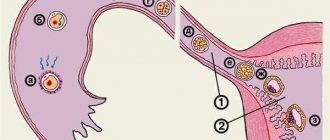For the most part, women have a very vague idea of their pregnancy, many dream and wait for it, many don’t even think about it, but when it comes, almost everyone (both the first and the second) experience a slight shock. However, after the state of shock passes and when the woman gets used to the idea that she is pregnant, she begins to be interested in very, very many questions relevant to the situation.
So, in fact, one of the first women begins to ask the question is when will their belly start to grow? Very soon the tummy will become rounded and will begin to protrude quite beautifully in front of its owner. However, at this stage, the real (full) awareness that right now a new life is developing inside you still does not come to the young woman. This sensation and awareness usually appears only with the first incomprehensible and weak (or rather, depending on who) movements of the baby.
And finally, the pregnant woman will receive the first signs of independence of the baby, and, undoubtedly, will feel like a real expectant mother! In fact, this is a truly incredibly exciting, and one might even say sacred, intimate moment associated with pregnancy and family. The happy woman urgently hurries to report her feelings to the baby’s father. Then they both sit for a long time, without moving, so that the baby’s father can feel small, subtle tremors...
Unfortunately, no matter what the father of the future baby is, and no matter how, in reality, the man waits for the birth of the little one, he is still not given the opportunity to 100% experience and feel these mysterious feelings so fully (like a woman).
Without a doubt, in the age of the Internet, every woman, from a certain stage of pregnancy, begins to wait for the appearance of signals from within. However, despite all the instructions and deadlines, the baby may well hide for a while... Sometimes the baby can even scare an overly impressionable expectant mother, who, having waited the due date, did not feel such important signals.
So how can you find out and understand that the first movements of your baby have already appeared? Is it possible to describe what they are, these movements and when exactly they appear. We will try to tell literally everything that all expectant mothers need to know about the long-awaited and not always clear movements of the unborn child.
At what age does a child begin to move?
The first movements occur during embryogenesis. This is on average 5-6 weeks from the moment of conception. By the end of the first trimester, the embryo is still too small to feel its movement.
The doctor records the activity on the ultrasound monitor and shows it to the expectant mother, but it is impossible to feel them.
Noticeable movements occur at 19-20 weeks of gestation. Perhaps earlier, especially for those women who have had experience of bearing and giving birth to a baby.
For experienced mothers, kicks occur at 16-17 weeks, sometimes earlier.
Firstborns start pushing at 17 weeks, but it is extremely difficult to notice and determine that these are the baby’s “messages.”
When the fetus gets stronger and its movements become more conscious, then first-time mothers will appreciate the beauty of the baby’s movements.
The absence of jerking sensations after 21 weeks of pregnancy is an unfavorable sign, so doctors, starting from the second trimester, are interested in the possible activity of the fetus.
The influence of odors
Prolonged exposure of a pregnant woman to certain odors also leads to increased motor activity of the fetus. The strong smell of chlorine, acetone, paint can irritate it. The child begins to spin around, trying to turn away from the unpleasant smell.
The greatest harm to the health of a pregnant woman and fetus is caused by smoking and the smell of tobacco smoke. Numerous studies of this problem have proven the negative impact of tobacco smoke on the intrauterine development of a child. If a pregnant woman smokes, it is extremely important to quit the habit as soon as possible. But the smell of smoke in the room can have a negative impact on the child.
When tobacco smoke enters the mother's body, the baby may begin to move very much. At this moment, he experiences oxygen starvation (hypoxia) and tries to cope with it. As soon as the mother leaves the smoky room into fresh air, the baby will calm down. Constant exposure to tobacco smoke, chlorine and other harmful odors can lead to chronic hypoxia, developmental delays, oligohydramnios and poor weight gain in the baby.
First sensations
Feelings about the development of new life in the womb are of a different nature. The first tremors are compared to the flapping of the wings of a butterfly or a fish swimming by, which gently touches the stomach and disappears again.
Some people notice gurgling sensations and sometimes associate them with indigestion.
The expectant mother can “hear” not only the baby knocking at her, but also the hiccups, in which case gurgling is precisely one of these signs.
Experienced pregnant women know the sensations, but according to their reviews, “they are always different, and begin at the most unexpected moment.”
One mother said that when she was expecting the first addition to the family, around the 18th week muscle spasms appeared in her stomach, which could be noticed in a lying position, but it never occurred to her that it was the baby who was starting to communicate with her.
Only when the “spasms” became a habit did the mother realize that the child was active. The first movements are noticeable, but they cannot be seen yet. As soon as the child grows up a little more, his “hello” will become noticeable to others.
What can remind, what are the very first baby movements similar to?
The reality is that the vast majority of women who have once experienced this exciting and unique life moment are completely confident that these sensations cannot be confused with anything. And, nevertheless, the very first movements of the baby are so light, gentle and almost imperceptible that you may not even pay due attention to them. Or, on the contrary, they are so incomprehensible that the movements of the little one can easily be mistaken for, say, overly active work of our intestines.
Modern mothers very affectionately call such primary, barely perceptible body movements – cute movements. Probably, a more accurate name cannot be chosen, because this is exactly what these movements actually are. Don't expect that you will suddenly feel a sharp blow to your stomach. Or you will feel your heel pressing into your rib.
The very first movement will definitely be almost airborne and, quite possibly, even phantom to some extent. And this is the only way that a variety of pregnant women are ready to describe this feeling. Women themselves usually use the following phrases to explain the movements they feel:
- It looks like a fish splashing its tail through the water.
- Perhaps, like a butterfly fluttering its wings.
- It looks like a light balloon rolling on the ground.
- Resembles an air bubble moving in water.
Remember, have you ever felt something like this? Know, most likely, these were those very unique little hairs.
The norm of movements at different periods
At different stages of gestation, the baby moves differently. From the moment of the first shock to the subsequent ones, 1 or even 2 days may pass.
When space in the uterus allows, the fetus makes about 250 movements, but the mother will not feel them all.
From the 20th week of gestation, no more than 10 strokes can be noted per day. By week 28, their number exceeds 500, and there are more superficial shocks: 6-8 shocks every hour.
In the middle of the second trimester, the fetus develops a sleep-wake pattern.
Most of the time he remains asleep, and movements become rare, but repeated periodically.
How does the intensity of mobility change at different times?
From 20 to 32 weeks, fetal activity gradually increases. The peak occurs at 32-33 weeks of gestation. Then the baby begins to move less often, but more intensely.
The reasons for this phenomenon are as follows:
- firstly, the child is getting bigger;
- secondly, strength and muscle tone appear;
- thirdly, there is still room in the uterus so that you can turn around or stretch.
The intensity of the movements can be expressed in the diagram:
- 20-22 weeks: 3-5 per hour;
- 22-24: from 5 to 7 per hour;
- 24-26: up to 10, but not less than 6 per hour;
- from 26 to 30: from 10 to 14 per hour;
- from 30 to 36: 8-14 per hour;
- from 36 to the end of pregnancy: from 6 to 12 per hour.
On average, the baby should move 10 times per hour.
The data is speculative, since at one hour he will actively push, and at another he will sleep, which means that movements will be sporadic or completely absent.
To some extent, the intensity of movements depends on the pace of life of the mother.
How fetal movements are manifested and felt
The sensations and nature of the tremors depend on many factors:
- Fetal presentation. If the baby's head is lowered down, then the intensity and jerking movements occur in the upper segment of the abdomen. Sometimes they are localized in the area of the right hypochondrium. With incorrect presentation, activity is expressed in internal beats of the lower segment of the rounded abdomen.
- Pregnant woman's pain threshold. Exceeding it is accompanied by painful sensations when moving.
- The character of the future baby. Excessive activity or, conversely, lethargy may be a sign of pathology, or it may be a character trait.
- Gestation period. As pregnancy progresses, brain activity and physiological strength improve. The fetus may react to loud sounds from the outside, the voice of the mother or relatives around her.
The blows fall in various places: the front of the abdominals, the back, the ribs, the groin area.
The more active the baby, the stronger his “hellos”. However, you need to be able to distinguish a physiological character trait from a possible pathological process.
Nature of movements
Weak tremors are observed in the early stages of gestation. Their presence in later stages, and especially in the last weeks, may indicate muscle weakness of the fetus, developmental abnormalities or intrauterine growth restriction syndrome.
Painful sensations are accompanied by other clinical symptoms and are associated with the underlying disease of the pregnant woman, for example, renal failure or varicose veins.
Painful kicks in moderation are normal, but only if your pregnancy is 35 weeks or older.
The reason for this is heavy weight or carrying several fetuses at the same time.
Uncomfortable pain may be a consequence of the uncomfortable position of the baby or mother, or have more serious causes. Painful blows may be confused with contractions.
Excessively active movements are a sign of the development of a lack of oxygen (hypoxia). Oxygen deficiency excites the nervous system of the fetus, and it, in turn, begins to “rage,” causing pain to the expectant mother.
Hypoxia can be confirmed or refuted using CTG or ultrasound.
Lack of oxygen has a detrimental effect on the baby and can lead to severe developmental disorders of the child.
Let us remind you when your unborn baby should start moving.
So, not all pregnant women know (or rather, not all believe it) that the fetus can begin to move from approximately 7 or at most 8 weeks of pregnancy. More precisely, when his age is only 5 or 6 weeks. This is due, first of all, to the beginning of the full development of the children's nervous system. Without a doubt, at this age, so to speak, the baby makes absolutely uncontrolled, completely chaotic movements. After all, the toddler is still so insignificantly small that even the expectant mother is simply not able to feel them behind the thickness of the abdominal wall.
Time passes and we must pay tribute to the speed of development of the baby. As he grows, the baby constantly and incredibly quickly improves his body movements. You can say thank you to Mother Nature, because this is exactly how (rather quickly) the neurons of a child’s brain establish their subsequent work. Gradually, coordination of all children's movements begins to occur, and naturally, the toddler's limbs gradually become stronger (at the same time, the hardening bones of the baby are overgrown with new muscle tissue). Further, the baby himself actively increases in size.
A certain time comes, and the little one is not only able to bend or straighten his limbs, now he can, depending on his mood, kick his mother with his little leg, making it clear that he doesn’t like something. Or the baby may push off slightly with his little hand, wanting to swim in the amniotic fluid.
It turns out, and not many people know, that in the mother’s big tummy there are a lot of extremely interesting and entertaining activities for the baby. As a rule, researchers claim that the baby can actively play with the umbilical cord and can clench its fists if desired. Sometimes babies in the womb can even do some kind of exercise by trying to reach their leg with their hand. It's hard to believe, but sometimes babies can even hide their faces in their hands, as if playing cuckoo. A baby can also hide his face if something accidentally scares him or he simply doesn’t like it.
Also, swimming in the still large amniotic fluid, a very small tadpole can quite noticeably hit its head or butt against the walls of the uterus. In fact, the expectant mother may be the first to begin to feel such strong tremors from the baby’s point of view.
Typically, this begins to happen between the sixteenth and twenty-second weeks. Moreover, for each specific woman, the period of appearance of the first movements varies radically. And some women may even perceive the first movements as some kind of bubbling of food in the stomach.
Some obstetricians say that a pregnant woman can actually feel the very first movements even a little earlier than the specified period. Especially if the woman is thin, emotional and attentive to her own feelings. Also, women with more experience and not their first pregnancy can feel the first movements of the baby at an earlier stage.
However, in practice, most primiparous women begin to fully feel the presence of their babies in their bellies at the sixteenth week. In any case, women who have already crossed their twenty-two week mark and have not felt any real movements should not be overly concerned.
It must be said that some women may simply not notice such movements, they are so invisible and unobtrusive, especially if the woman is active and constantly busy at work. Some women, as we have already said, may confuse baby movements with increased peristalsis, especially since some digestive disorders were observed in the first weeks of pregnancy.
So how can you manage and not miss such an exciting and unique initial acquaintance with your little one, your Katya or Maximka?
Why count movements?
To determine the normal value of movements, a special test has been developed, during which the tremors are counted.
The technique is as follows:
- movement counting begins at 28 weeks of gestation;
- the expectant mother must refuse to do any business during this period;
- counting starts at 9 a.m. and ends at 9 p.m.;
- any movements are taken into account (small, light, heavy, etc.);
- the normal value is 10 or more movements;
- In order not to lose track of your calculations, you need to keep a map or regular records.
A test for the amount of movement is necessary to assess the condition of the fetus.
If the fetus moves less than 10 times, this is a serious reason to consult a doctor.
The absence of tremors for 12 hours carries an unfavorable prognosis.
What to do if the child does not move for a long time
The baby should not always be in an active state. Normally, during your stay in the womb, the time does not exceed 3-4 hours per day. This means that the baby sleeps more often, occasionally interrupting to communicate with his mother.
There are several methods for forcing the baby to wake up:
- eat chocolate, candy or a sweet drink;
- drink hot tea;
- stroke and tap the stomach;
- play loud music or shine a bright light on your stomach.
The methods are questionable, but sometimes effective.
If the child does not contact for more than 12 hours, and the above methods do not help, you can do something crazy - listen to the heartbeat yourself using a stethoscope.
After 30 weeks, it is possible to hear heartbeats, but it is impossible to assess their quality.
The most appropriate action would be to seek medical help.
You can also call your treating gynecologist-obstetrician and tell him about the problem.
If the fetus does not move for a long time, it most likely has serious health problems.
The need to control the baby's movements
You need to know that at the very beginning of pregnancy, your baby’s movements will be extremely gentle and relatively infrequent. Or rather, you will understand that the baby is moving and sleeping.
However, it is important not to be scared and to know that a woman at this stage is not able to feel all the existing movements of the baby. However, already from the twenty-eighth week, as most doctors believe, the fetus can grow quite enough for any woman to fully feel it and even learn to clearly understand it.
It is extremely important for expectant mothers to know that regular, preferably calm, movements of their unborn child are in fact an extremely important moment and even a vital sign. Doctors are convinced that by the nature and also by the number of such movements it is possible to assume how comfortable the unborn baby feels while in the mother’s womb. Moreover, by such movements it is quite possible to judge the development of the toddler.
This is probably why many gynecologists advise all their pregnant patients to periodically monitor such children’s movements every day. Let us remind you that it makes sense to control movements only starting from the twenty-eighth week of pregnancy and not earlier.
And for such control it is necessary to learn to record literally every group or every series of children's movements. It is considered an excellent indicator if you can count on average about ten similar series or “entries” of children’s activity within one day.
If we are not talking about series of movements, but simply about their total number of movements, then at least ten of them should be felt during every three hours. However, today there are many other ways to maintain full control over the children’s perceptible movements.
For example, the so-called Dr. Pearson test is very popular today. This is also called the “Count to Ten” method. So the point of this test is to record literally every tenth child’s movement on a strictly special tablet. Moreover, movements should be counted in the time interval between nine o’clock in the morning and nine o’clock in the evening. So, over the course of a whole day, a pregnant woman should record about ten such movements.
In cases where a woman at a certain point stops feeling any movements and it seems to her that they have disappeared completely, she can try to do another important test:
- First, you should have a snack of something tasty or even a hearty meal, of course, if you are already hungry. Doctors are convinced that babies in the womb can react especially vividly to sweets received by their mother’s body. After this, your baby will have to become more active. And in the next two or three hours, normally you will need to count about five or ten new movements.
- If nothing has changed after eating, try to carefully become active on your own. Let's say, do some very light, but definitely physical labor. You can just take a walk, or do special gymnastics for pregnant women. However, then try to lie down (it will be better if you choose your left side for this) and listen again. It is important to remember that the most alarming sign in this case will be the complete absence of any movements of the baby over the next three hours.
Note that in later stages of pregnancy you can even simply shine a flashlight directly on your stomach or turn on your favorite music louder. As a rule, babies react well to sudden changes in lighting and, of course, to various sounds that are pleasant for the expectant mother.
A real reason to be wary is considered to be excessively increased (painful) or decreased (even absent) activity of the baby in the womb of the expectant mother. It is believed that if there is excessive activity in the womb, the baby may significantly lack incoming oxygen. In such cases, the baby begins to actively massage and tug at the placenta in order to somehow obtain the necessary oxygen. In case of excessive calmness, there is a dangerous possibility that the baby is lagging behind in development or there are significant disturbances in it.
It is also important to understand that not always and not under all circumstances should one take complete silence or the riot happening inside literally. You must agree that at this time this is, in general, the only way for a baby to be able to convey his own “point of view” or “his own mood” to his mother. This is, in general, why doctors recommend that from the very first movements you try to learn how to fully communicate with your own baby and at the same time understand all the signs from each other.
By the way, children's intrauterine activity can often increase in a state of complete rest of the expectant mother. Perhaps the baby is also worried about why his mother is not active.
But seriously speaking, firstly, this is justified by the fact that during the movements of your body, which occur throughout the day, a pleasant calming and lulling of the baby occurs. And secondly, the woman herself becomes a little more sensitive and more focused the moment she lies down and completely relaxes. So, as a rule, a pregnant woman can always expect another session of stirring or even beating her mother by the end of the night.











